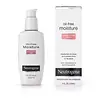Hada Labo Hydrating Light Cream Versus Neutrogena Oil Free Face & Neck Moisturizer for Combination Skin
What's inside
What's inside
 Key Ingredients
Key Ingredients

 Benefits
Benefits

 Concerns
Concerns

 Ingredients Side-by-side
Ingredients Side-by-side

Water
Skin ConditioningCyclopentasiloxane
EmollientCaprylic/Capric Triglyceride
MaskingButylene Glycol
HumectantGlycerin
HumectantHydrogenated Polydecene
EmollientPolysorbate 20
EmulsifyingDimethicone
EmollientHydroxyethyl Acrylate/Sodium Acryloyldimethyl Taurate Copolymer
Emulsion StabilisingSqualane
EmollientIsononyl Isononanoate
EmollientAmmonium Acryloyldimethyltaurate/Vp Copolymer
Sorbitol
HumectantBetaine
HumectantPhenoxyethanol
PreservativeEthylhexylglycerin
Skin ConditioningGlyceryl Caprylate
EmollientPolysorbate 60
EmulsifyingSodium Hyaluronate
HumectantDimethicone/Vinyl Dimethicone Crosspolymer
Skin ConditioningGlyceryl Polyacrylate
Xanthan Gum
EmulsifyingDisodium EDTA
Allantoin
Skin ConditioningSorbitan Isostearate
EmulsifyingArginine
MaskingPolyglyceryl-10 Stearate
Skin ConditioningCeramide NP
Skin ConditioningCeteareth-20
CleansingBeta-Glucan
Skin ConditioningAloe Barbadensis Leaf Juice
Skin Conditioning1,2-Hexanediol
Skin ConditioningPropanediol
SolventSodium Acetylated Hyaluronate
HumectantHyaluronic Acid
HumectantPaeonia Albiflora Root Extract
Skin ConditioningPiper Methysticum Root Extract
Skin ConditioningPortulaca Oleracea Extract
Skin ConditioningUlmus Davidiana Root Extract
Skin ConditioningSodium Benzoate
MaskingCitric Acid
BufferingPotassium Sorbate
PreservativeSoluble Collagen
HumectantSodium Chloride
MaskingWater, Cyclopentasiloxane, Caprylic/Capric Triglyceride, Butylene Glycol, Glycerin, Hydrogenated Polydecene, Polysorbate 20, Dimethicone, Hydroxyethyl Acrylate/Sodium Acryloyldimethyl Taurate Copolymer, Squalane, Isononyl Isononanoate, Ammonium Acryloyldimethyltaurate/Vp Copolymer, Sorbitol, Betaine, Phenoxyethanol, Ethylhexylglycerin, Glyceryl Caprylate, Polysorbate 60, Sodium Hyaluronate, Dimethicone/Vinyl Dimethicone Crosspolymer, Glyceryl Polyacrylate, Xanthan Gum, Disodium EDTA, Allantoin, Sorbitan Isostearate, Arginine, Polyglyceryl-10 Stearate, Ceramide NP, Ceteareth-20, Beta-Glucan, Aloe Barbadensis Leaf Juice, 1,2-Hexanediol, Propanediol, Sodium Acetylated Hyaluronate, Hyaluronic Acid, Paeonia Albiflora Root Extract, Piper Methysticum Root Extract, Portulaca Oleracea Extract, Ulmus Davidiana Root Extract, Sodium Benzoate, Citric Acid, Potassium Sorbate, Soluble Collagen, Sodium Chloride
Water
Skin ConditioningCyclomethicone
EmollientCetyl Ethylhexanoate
EmollientGlycerin
HumectantCetyl Ricinoleate
EmollientStearyl Alcohol
EmollientGlyceryl Stearate
EmollientPEG-100 Stearate
Methyl Methacrylate
Glycol Dimethacrylate Crosspolymer
Lysine Carboxymethyl Cysteinate
Skin ConditioningLysine Thiazolidine Carboxylate
Skin ConditioningTocopherol
AntioxidantSilica
AbrasiveXanthan Gum
EmulsifyingMethylparaben
PreservativePropylparaben
PreservativeDiazolidinyl Urea
PreservativeBenzalkonium Chloride
AntimicrobialWater, Cyclomethicone, Cetyl Ethylhexanoate, Glycerin, Cetyl Ricinoleate, Stearyl Alcohol, Glyceryl Stearate, PEG-100 Stearate, Methyl Methacrylate, Glycol Dimethacrylate Crosspolymer, Lysine Carboxymethyl Cysteinate, Lysine Thiazolidine Carboxylate, Tocopherol, Silica, Xanthan Gum, Methylparaben, Propylparaben, Diazolidinyl Urea, Benzalkonium Chloride
Ingredients Explained
These ingredients are found in both products.
Ingredients higher up in an ingredient list are typically present in a larger amount.
Glycerin is already naturally found in your skin. It helps moisturize and protect your skin.
A study from 2016 found glycerin to be more effective as a humectant than AHAs and hyaluronic acid.
As a humectant, it helps the skin stay hydrated by pulling moisture to your skin. The low molecular weight of glycerin allows it to pull moisture into the deeper layers of your skin.
Hydrated skin improves your skin barrier; Your skin barrier helps protect against irritants and bacteria.
Glycerin has also been found to have antimicrobial and antiviral properties. Due to these properties, glycerin is often used in wound and burn treatments.
In cosmetics, glycerin is usually derived from plants such as soybean or palm. However, it can also be sourced from animals, such as tallow or animal fat.
This ingredient is organic, colorless, odorless, and non-toxic.
Glycerin is the name for this ingredient in American English. British English uses Glycerol/Glycerine.
Learn more about GlycerinWater. It's the most common cosmetic ingredient of all. You'll usually see it at the top of ingredient lists, meaning that it makes up the largest part of the product.
So why is it so popular? Water most often acts as a solvent - this means that it helps dissolve other ingredients into the formulation.
You'll also recognize water as that liquid we all need to stay alive. If you see this, drink a glass of water. Stay hydrated!
Learn more about WaterXanthan gum is used as a stabilizer and thickener within cosmetic products. It helps give products a sticky, thick feeling - preventing them from being too runny.
On the technical side of things, xanthan gum is a polysaccharide - a combination consisting of multiple sugar molecules bonded together.
Xanthan gum is a pretty common and great ingredient. It is a natural, non-toxic, non-irritating ingredient that is also commonly used in food products.
Learn more about Xanthan Gum